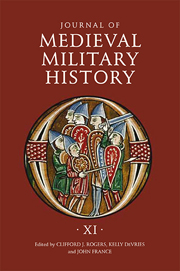Book contents
- Frontmatter
- Contents
- List of Illustrations and Tables
- 1 Military Games and the Training of the Infantry
- 2 The Battle of Civitate: A Plausible Account
- 3 The Square “Fighting March” of the Crusaders at the battle of Ascalon (1099)
- 4 How the Crusades Could Have Been Won: King Baldwin II of Jerusalem's Campaigns against Aleppo (1124–5) and Damascus (1129)
- 5 Saint Catherine's Day Miracle – the Battle of Montgisard
- 6 The Military Effectiveness of Alan Mercenaries in Byzantium, 1301–1306
- 7 Winning and Recalling Honor in Spain: Pro-English Poetry in Celebration of the Battle of Nájera (1367)
- 8 The Wars and the Army of the Duke of Cephalonia Carlo I Tocco (c. 1375–1429)
- 9 Sir John Radcliffe, K.G. (d. 1441): Miles Famossissimus
- 10 Defense Schemes of Southampton in the Late Medieval Period, 1300–1500
- 11 French and English Acceptance of Medieval Gunpowder Weaponry
- Journal of Medieval Military History 1477–545X
1 - Military Games and the Training of the Infantry
Published online by Cambridge University Press: 05 October 2013
- Frontmatter
- Contents
- List of Illustrations and Tables
- 1 Military Games and the Training of the Infantry
- 2 The Battle of Civitate: A Plausible Account
- 3 The Square “Fighting March” of the Crusaders at the battle of Ascalon (1099)
- 4 How the Crusades Could Have Been Won: King Baldwin II of Jerusalem's Campaigns against Aleppo (1124–5) and Damascus (1129)
- 5 Saint Catherine's Day Miracle – the Battle of Montgisard
- 6 The Military Effectiveness of Alan Mercenaries in Byzantium, 1301–1306
- 7 Winning and Recalling Honor in Spain: Pro-English Poetry in Celebration of the Battle of Nájera (1367)
- 8 The Wars and the Army of the Duke of Cephalonia Carlo I Tocco (c. 1375–1429)
- 9 Sir John Radcliffe, K.G. (d. 1441): Miles Famossissimus
- 10 Defense Schemes of Southampton in the Late Medieval Period, 1300–1500
- 11 French and English Acceptance of Medieval Gunpowder Weaponry
- Journal of Medieval Military History 1477–545X
Summary
[“I giochi militari e l'addestramento delle fanterie,” in Aldo A. Settia, Comuni in guerra. Armi ed eserciti nell'Italia delle città (Bologna, 1994), pp. 29–52]
Translated by Valerie EadsThe “Little Battles”
Italian communal armies were, as is well known, largely made up of infantry. Admittedly, the strength of these latter would have resulted more from numbers and determination than from combat experience; still, the term “infantry” properly means “a group of soldiers with a certain level of training and discipline,” two qualities that result only from some form of instruction. And yet, if we wish to develop at least a rough understanding of the military obligations of the mass of the population, of the armament the people had to provide for themselves, and of how it (the population) was mobilized to train for war – with the exception of some late provisions concerning marksmen – the sources as a rule are simply silent concerning training.
One can certainly maintain that economic reasons would have prevented regular exercises for the communal infantry in times of peace, but it is difficult to believe that all training would have taken place on the battlefield or in the course of the socio-political conflicts between milites and pedites. There is, however, a third possibility offered by certain war games – a sort of plebeian rival to the aristocratic tournaments – practiced specifically by those classes that furnished the infantry for the city militia.
- Type
- Chapter
- Information
- Journal of Medieval Military HistoryVolume XI, pp. 1 - 24Publisher: Boydell & BrewerPrint publication year: 2013

